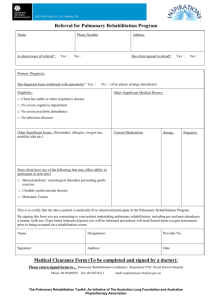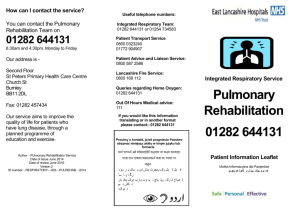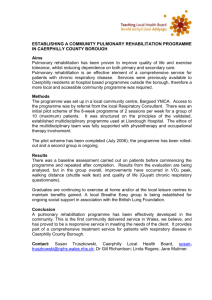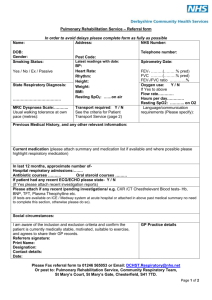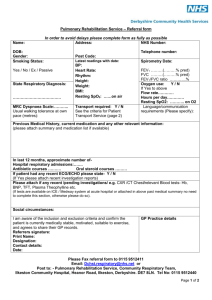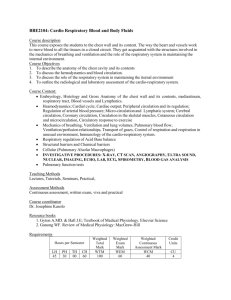Kingdom of Saudi Arabia
advertisement
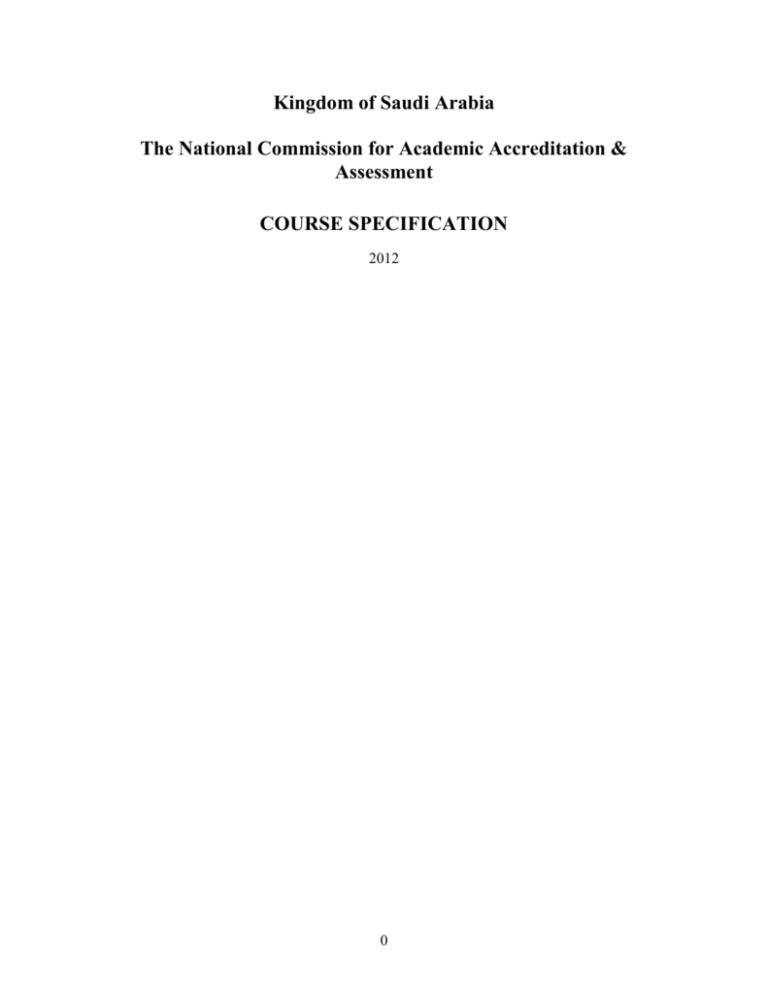
Kingdom of Saudi Arabia The National Commission for Academic Accreditation & Assessment COURSE SPECIFICATION 2012 0 Course Specification Institution: King Saud University College/Department: College of Applied Medical Sciences/Rehabilitation Sciences- Physical Therapy A Course Identification and General Information 1. Course title and code: Chest Physical Therapy 2. Credit hours1+1=2 3. Program(s) in which the course is offered: Physical Therapy 4. Name of faculty member responsible for the course: Male side: Dr. Farag Abul Moniaam Office:…..Ext 479:….. E-mail address: cazoza @hotmal.com…….. Office Hours:…..Tutorial Hours Mr. Mansour Alghamdi PT, MSHS (Lecturer), Office 2077, Ext: 98638, E-mail: msghamdi@ksu.edu.sa 5. Level/year at which this course is offered: Level 8/ fourth year 6. Pre-requisites for this course (if any): 7. Co-requisites for this course (if any): N/A 8. Location if not on main campus: N/A 1 B Objectives 1. Summary of the main learning outcomes for students enrolled in the course: 1- Student should be able to evaluate patients with pulmonary disorders, identify patient’s problems and implement the proper physical therapy modality and/ or technique. 2- Student should be capable of measuring the effectiveness of Physical Therapy rehabilitation program. 3- Student should practice within the ethical and professional standards of the health institution. On successfully completing the course, the student must: 12345678910111213- Be knowledgeable of the anatomy and physiology of the Respiratory system. Has the knowledge of signs and symptoms of patient with pulmonary disorders. Demonstrate the ability to conduct the proper evaluative procedure (s) to the patient. Prioritize the patient’s problem (s). Identify the goals of physical therapy rehabilitation. Demonstrate judge wise in selecting the physical therapy modality. Master implementation of the physical therapy modality. Be Capable to design an assessment measure to test the effective of the treatment. Be able to practice as part of the health services team work within the standardized professional behavior. Practice with respect to the standards ethics of the institution and culture of the community. Show fair communication skills. Act as a decision maker. Knowledgeable of IT. 2. Briefly describe any plans for developing and improving the course that are being implemented. (eg increased use of IT or web based reference material, changes in content as a result of new research in the field) Self assessment will be conducted using the following: 1- Feed back report form full field by the students. 2- Employee survey fullfield by the heads of physical therapy departments at hospitals. 3- Conduct a basic statistical analysis to the 2 surveys by the course instructor. 4- Analyse the results of the 2 surveys by the course instructor. 5- Identify the point of strength and that of weakness. 6- Discuses the results with the curriculum committee of the department. 7- Curriculum committee create a plan to develop and improve the course. 8- Submit the curriculum committee proposal to the college council. C. Course Description : In this course normal structural and functional basis of the respiratory system are presented and discussed. Terminology of the physical therapy for chest diseases is also included. This is followed by discussions and practical demonstration of general and specific evaluation procedures and their rationales for use with patients suffering from particular problem will be followed respiratory problems. The student will be trained on how to select the appropriate physical therapy procedures for different chest problems and how to plan the treatment programs. Implementation of physical therapy programs using therapeutic skills for each part 2 1. TOPICS to be COVERED 1 Contact Hours 1 1 1 1 1 0.5 1 2 1 1 1 1 1 1 0.5 1 2 1 1 1 1 1 1 1.5 1 1 16 1.5 1 1 16 No. of Weeks Anatomy and physiology of the pulmonary system. And Announce of individual & one group assignment Basic terms of chest disease Assessment of patient with pulmonary problem. Signs and symptoms of pulmonaryr problems Respiratory failure Pneumonia Mid term exam.1 theoretical and clinical Chronic obstructive lung disease, postural drainge. Plural disease, and restrictive lung diseases Occupational lung disease, application of selected modalities Corpulmonal. Chest surgery, Application of selected physical therapy modalities in chest surgery Pulmonary rehabilitation Continue pulmonary rehabilitation Final Assessment Total Hours with Assessment 2 Course components (total contact hours per semester): Lecture: Tutorial: 16 45 Practical/Fieldwork /Internship: 48 Other: Office hours: 16 3. Additional private study/learning hours expected for students per week. 3Hours 3 4. Development of Learning Outcomes in Domains of Learning For each of the domains of learning shown below indicate: A brief summary of the knowledge or skill the course is intended to develop; A description of the teaching strategies to be used in the course to develop that knowledge or skill; The methods of student assessment to be used in the course to evaluate learning outcomes in the domain concerned. a. Knowledge 12345- anatomy and physiology of pulmonary system. Signs & symptoms of the Respiratory problems. Most common Respiratory problems. Physiotherapy assessment of patient with Respiratory problem. Different treatment protpcols for patients with pulmonary disorders (ii) Teaching strategies to be used to develop that knowledge 1. Lectures. 2. Tutorials. 3. Individual assignment. (iii) Methods of assessment of knowledge acquired 1. 5 minute multiple choice Quiz in the beginning of each lecture with results carrying 10% of final assessment. 2. Multiple choice & short assay knowledge items on mid term and final exams carrying 50% of the total mark. 3. Student presentations with the results carrying 10% of final assessment. b. Cognitive Skills (i) Cognitive skills to be developed 1. 2. The ability to prioritize the patient’s problem. The ability to establish the short and long term goals of the physiotherapy protocol. 3. The ability to critically appraise the effectiveness of physiotherapy protocol. (ii) Teaching strategies to be used to develop these cognitive skills 1. Examples of case study given in the lecture. 4 2. Practice under supervision in hospitals. (iii) Methods of assessment of students cognitive skills 1. Assignment in form of problem to be solved. 2. Measure student participation in problem solving open discussion. 3. Implementation of OSCE in the mid term and final exams. 4. Quizzes in the end of each topic with problem solving questions. c. Interpersonal Skills and Responsibility (i) Description of the interpersonal skills and capacity to carry responsibility to be developed 1. The ability to be a decision maker. 2. The ability to work as a leader. 3. The ability to be long life learner. 4. The ability to practice with respect to the responsibility toward patients, community, and physiotherapy carrier. (ii) Teaching strategies to be used to develop these skills and abilities 1. Students will be trained on simulating situations 2. On site clinical practice in which students will be assigned to a particular patient and will be held responsible under supervision. One group assignment. 3. (iii) Methods of assessment of students interpersonal skills and capacity to carry responsibility 1. presentation & discussion of the group assignment. 2. Implementation of OSCE in the mid term and final exams. d. Communication, Information Technology and Numerical Skills (i) 1. Description of the skills to be developed in this domain. The ability to document the patient’s information in written. 5 2. 3. 4. 5. 6. The ability to conduct oral presentation to the patient’s condition. The ability to be an active participator on the health service team work. The ability to practice within the ethical, cultural, and professional standards. The ability to use the IT in the practice as in documentation and for research purposes. The ability to use mathematical or statistical information for data representation. (ii) Teaching strategies to be used to develop these skills 1. 2. 3. 4. Implement the SOAP documentation in clinical practice. Students are required to make an oral presentations of their cases in hospitals. Students are required to submit web site reference for their assignment and use power point program for presentation. One group assignment. (iii) Methods of assessment of students numerical and communication skills 1. Implementation of OSCE in mid term & final exams. 2. 3. Assessment of student’s assignment presentation with carrying 10% of course work. Assign 10% of course work for student professional behaviour. e. Psychomotor Skills (if applicable) (i) Description of the psychomotor skills to be developed and the level of performance required The ability to conduct the manual physiotherapy modalities within the acceptable standards. (ii) Teaching strategies to be used to develop these skills On site practice. (iii) Methods of assessment of students psychomotor skills Implementation of OSCE in mid term & final exams. 5. Schedule of Assessment Tasks for Students During the Semester Assess ment Assessment task (eg. essay, test, group project, examination etc.) Week due 1 Every week quiz. 2- 14 Proportion of Final Assessment 10% 2 Announce of individual & one group assignment 2 10% 3 Submission of individual assignment 7 10% 4 Presentation of one group assignment. 15 10% 5 Mid term exam. 7 20% 6 6 Final exam. 16 40% D. Student Support Each week the course instructor will be available in her office for 2 hours for individual student consultation & for one hour for academic advising. E Learning Resources 1- Required Text book 1- Chest Physical Therapy and Pulmonary Rehabilitation : An Interdisciplinary Approach , Donna L. Frswnfelter , published by year Book Medical Publisher Inc Chicago 2- The Brompton Hospital Guide to Chest physical Therapy , Gaskell D.V. and Webber B.A Published by Blackwell Scientific Publication , London 2. Essential References 1-Cash,s Textbook; Chest, heart, and vascular disorder for Physical therapy, Patricia A. Dawine , published by Faber and Faber , London. 3- Recommended Books and Reference Material (Journals, Reports, etc) (Attach List) A-American chest Association Journals B- Journal of Physical therapy 4-.Electronic Materials, Web Sites etc A- American Physical Therapy Association website. 7 F. Facilities Required Lab room including 30 seats at least Computing resources *Internet *membership in web based mental health nursing *membership in evidence-based mental health nursing sites 4. Other resources Video recording apparatus and facility Conviction mirror Magmatic teaching board PowerPoint/ transparency projector Teaching lab dolls and equipments relevant to nursing procedure included in course G Course Evaluation and Improvement Processes 1 Strategies for Obtaining Student Feedback on Effectiveness of Teaching Confidential instructor evaluation questionnaire on completion of the course. 2 Other Strategies for Evaluation of Teaching by the Instructor or by the Department Student feed back report to be analysed by the course instructor and submit the results to the department head. 3 Processes for Improvement of Teaching 1. 2. 3. 4. Review the students feed back and work on the weak points. Conduct departmental workshops to discuss how to support the teaching process. Attend educational courses of teaching methodology. Appoint percentage of department budget for educational resources as text books, audio-visual materials (LCD, CD, computers, scanner, printer, flash memory….), anatomical models, physical therapy equipment & financial support to attend courses and conferences. 8 4. Processes for Verifying Standards of Student Achievement (eg. check marking by an independent faculty member of a sample of student work, periodic exchange and remarking of a sample of assignments with a faculty member in another institution) Appoint board for OSCE formed from faculties from different institutions. 5 Describe the planning arrangements for periodically reviewing course effectiveness and planning for improvement. 1. 2. 3. 4. 5. Design graduate survey and employee surveys. Analyse the results of the two surveys and detect the weakness & strengthens in the course. Recognize action plane regarding the course credits, content, depth, breadth, teaching methodology. Submit a course report to the curriculum committee in the department to discuss the action plane. Submit the final action plane to the department Councill for approval. 9


